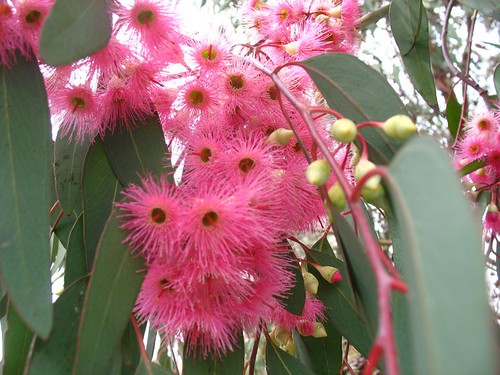
The sideroxylon can be quickly distinguished from other common eucalypts in California by its thick, dark, crusty bark--nearly black, with orange highlights in inch(es)-deep crevices--from which sometimes seeps a rust-colored exudate. Ascending main branches taper off in long, weeping red stems that bear green, glabrous, lanceolate leaves, 2-5 inches long, alternate and simple.
Depending on the authority, the Myrtaceae contains 80-160+ genera, several of which are commonly found as imported ornamentals (and/or weeds; often noxious) in California: Agonis, Acacia, Callistemon, Eugenia, Leptospermum, Melaleuca, Metrosideros, Myrtus, Tristania, others. California has at least one native genus, Myrica, as in Myrica californica, the Pacific Wax Myrtle.
As San Francisco street trees, E. sideroxylon commonly grows 40-60 feet high, so the pink/magenta flowers are often too far overhead to see. The specimen in the picture is growing at the bottom of a slope behind my office's elevated parking lot.
Many eucalypts have unremarkable flowers, but these are lovely. Many stamens, no petals. I see nectar in the circular groove that separates the stamens from the central pistil.

I tasted it; really nice--sweet and herbal.

2 comments:
Wow those ARE pretty! They almost look fake!
Post a Comment